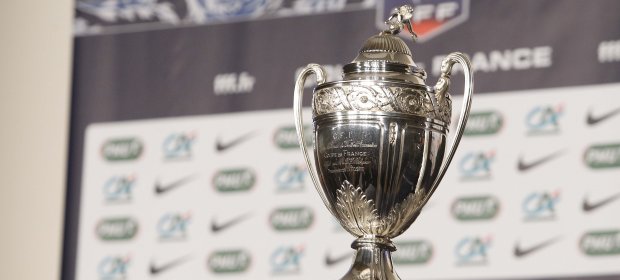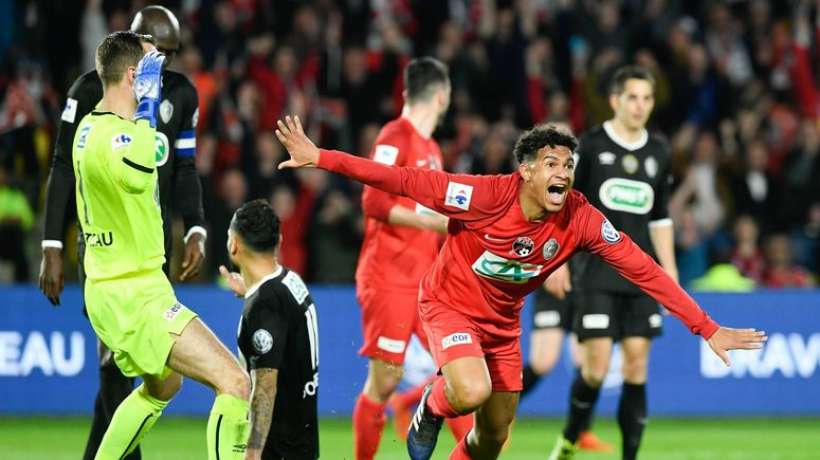On Tuesday evening the French Cup reaches its conclusion, as Ligue 1 champions and holders Paris Saint Germain take on third tier Les Herbiers. This kind of mismatch is nothing new for the competition, with lower league sides a regular fixture in the final stages. In preparation for the final, we’ve had a look at the story behind the biggest and best domestic cup competition in the world, and see whether 2018s minnows have even half a chance of causing an upset.
“On est à Paris, on est à Paris!”. The jubilant chant from the home supporters inside the 5,000 capacity Stade Massabielle combined joy with disbelief. They had just seen their team beat fellow Championnat National side FC Chambly 2-0 to book their place in the Coupe De France final – a five round improvement on their previous best finish in the competition. In the French Cup, however, dreams can come true, and they often do. In England we’ve been brought up to believe that the FA Cup is the greatest knockout competition going, that every now and then the minnows will have their day and get one over a traditionally big side, that anything can happen. But the older we get the more cynical we become about the so-called ‘magic of the cup’. In France, the magic really does exist. Les Herbiers are the third semi-professional side to reach the Coupe De France final since the turn of the century. In that same time, the FA Cup has seen two finalists from the second tier. This is cupset in concentrate.
The opportunity for shocks knocks largely due to the format of the competition – first of all around 184 teams enter the FA Cup every year, while the number of competitors in France is almost twenty times that. Secondly, because of the structure of the leagues – professionalism beyond Ligue 2 is yet to be introduced – the talent pool for lower league sides is much greater, and many of the teams competing in the Championnat National are able to boast former youth teamers from the likes of PSG, Lyon and Marseille, rather than jobbing joiners from Pontefract who often struggle to make training because they’re working late. As a result, the depth of quality from the top division to non-league is nowhere close to that in England, and consequently third and fourth tier sides are able to match their full-time opponents with skill and ability rather than just a boggy pitch and a hostile environment. The French Football Federation also went someway in levelling the playing field in the cup in 1974 when the introduced the Home Rule, which meant that any side drawn against a team two or more leagues above them would automatically be rewarded with home advantage – not only giving the lower league side more of a chance to progress in the competition, but also reward their progress with lucrative gate receipts. Given that teams beyond the second tier will have fought their way through nine rounds of cup football before the chance of meeting a Ligue 1 side even rears its head, its sort of fair enough to give them preferential treatment in what is a grueling competition. The preliminary rounds of the Coupe De France comprise of six stages in which teams face off within their own regions in order to join the competition proper in round seven. These regions are not restricted to mainland France, and take in French territories as far flung as Tahiti (Oceania), French Guiana (South America), Mayotte (West Africa), and Guadeloupe (Caribbean). This season eleven overseas teams emerged from the preliminary rounds, and all but two were immediately knocked out. Neither of those made it past round eight – but they wouldn’t have to wait long to try again. With the eighth round concluding at the beginning of December, and the winter break following shortly after, the Coupe De France preliminary rounds for 2018/19 kicked off in April in Mayonette. Yes – this is a cup competition that never ends.

The Coupe De France was the brain-child of Henri Delauney, and if you recognise that name it’s because he’s the man that brought us the European Championships, the trophy for which carries his name, and was also an early proponent of the European Cup. Delauney was keen to introduce a cup competition open to any French side that wanted to enter and, despite vocal opposition, the FFF opened the doors to all and sundry. The very first edition of the tournament comprised 48 teams and was won by the now defunct Olympique de Pantin from Paris, who would later become part of the side known today as Red Star, beating FC Lyon 3-0 in the final. Expansion of the tournament came thick and fast, and ten years later 336 teams entered the competition eventually won by Red Star themselves. Two years later, in 1930, the National Council of the FFF voted in favour of adopting professionalism in French football, and 1932/33 saw the inaugural season of Ligue 1. The following three seasons saw the newly professional French sides dominate the cup, but in 1936 OFC Charleville became the first second tier side to reach the final, going on to lose 1-0 to Racing Club Paris. By now the number of entrants into the competition was creeping up year on year, and in 1950/51 the Coupe De France reached over a thousand competitors. In 1959 the trophy was won by a second tier side for the first time as Le Havre took Sochaux to a replay before running out 3-0 winners at Colombes, before Saint Etienne and Marseille began a duopoly on the trophy, winning it eight times between them over the next couple of decades. In 1996 Nimes Olympique became the first side from the third tier to appear in the final, again losing out narrowly to Ligue 1 opposition, in the shape of AJ Auxerre, and in 2000 Calais went one better by reaching the final against Nantes as a fourth-division side, only to lose out to a last minute penalty. In total fifteen teams outside the top division have made it to the final of the Coupe de France, though only Guingamp have added their name to Le Havre as lower league winners, after overcoming Rennes in 2009. That game saw the highest recorded attendance at a Coupe de France final, with 80,056 cramming into the Stade de France to see a double from Eduardo help the Brittany based club lift the trophy for the first time. Since 2012 the tournament has seen 7,656 clubs in total enter.
Because of the home weighting afforded to semi-professional sides it’s rare that a season passes without, what English football supporters and pundits would deem, a few shocks. This season Strasbourg were knocked out in the quarter-finals by FC Chambly, while Nancy were humbled by CA Bastia in 2017. Perhaps the biggest single-tie shock in the modern era came during the 2014/15 season, when fourth tier Grenoble Foot beat Marseille on penalties after Sélim Bengriba had netted a 120th minute equaliser for the minnows. The Marseille team boasted Andre Ayew, Michy Batshuayi and Dimitri Payet, but Florian Thauvin’s miss from the spot was enough to see Grenoble into the Round of 32. Calais’ run to the final in 2000 wasn’t thanks to the luck of the draw either. Having been rewarded for a penalty shootout victory over Lille with the somewhat straightforward prospect of facing fifth tier Langon-Castets-en-Dorthe, Calais then needed a second penalty shootout to see off Cannes in the round of 16. A tight victory over Strasbourg – clearly no strangers to a cupset – set up a semi-final against reigning Ligue 1 champions Bordeaux. Despite having the talents of Christophe Dugarry, Lilian Laslandes, Johan Micoud and Sylvain Legwinski to call on, Élie Baup’s team were unable to break the fourth-tier side down, and Calais ran riot in extra-time, with two goals in six minutes wrapping up a 3-0 victory. They even took the lead in the final through Jérôme Dutitre, but an Antoine Sibierski double prevented Calais’ incredible story having the happiest of endings.

Perhaps Les Herbiers can upset the odds and become the first semi-professional side to lift the trophy. Though they’re yet to meet a top tier side on their run to the final, the team from Vendee have knocked out two Ligue 2 outfits, with an emphatic victory at Auxerre followed up by a penalty shootout win against 1998 French champions Lens. In the league, Les Herbiers find themselves in the midst of a relegation battle. A run of ten games without a win between September and January meant the cup offered a welcome distraction for Stéphane Masala’s team, but with just two games of the season remaining they sit third from bottom and face the prospect of relegation. Masala’s team has a strong African influence, and Ivorian forward Ambroise Gboho is joint scorer this season with French midfielder Kévin Rocheteau. Elsewhere in midfield, Togolese winger Claude Koutob and Cameroonian box-to-box man Rodrigue Bongongui provide both grit and guile – the latter has scored four times during this cup run. There’s plenty of experience at the highest level, too – defenders Quentin Bonnet and Roman Laspalles started their careers with Nantes and Rennes respectively, while January signing Florian David was brought through the youth ranks at Toulouse.
If they’re to make history they’re going to have to stop the all-conquering Paris Saint Germain side, and its unlikely they’ll have come up against the likes of Kylian Mbappe, Edinson Cavani or Angel Di Maria on a weekly basis in the National League. PSG themselves are chasing an unprecedented third domestic treble, and the odds will be stacked in their favour. If history teaches us anything, it’ll be a close game at the Stade de France, but if Les Herbiers can get the rub of the green anything can happen.